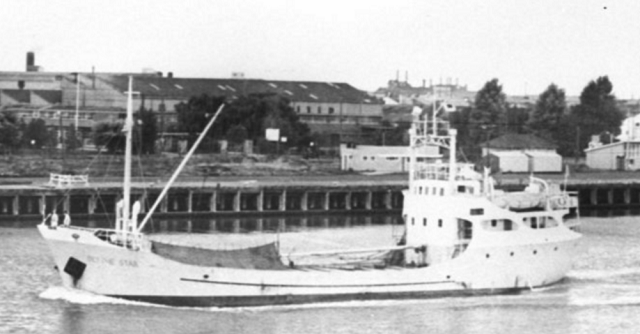The Unsung Heroes of the Blythe Star
For the first time in 42 years, ship wreck survivor Mick Doleman has told his story about what happened when the Blythe Star sank off the west coast of Tasmania in Australia to Channel 7’s Sunday Night.
 Mick Doleman is the only living survivor of the 10-man crew. It’s taken him 42 years to tell the full story of what happened — to anyone, including his wife and kids.
Mick Doleman is the only living survivor of the 10-man crew. It’s taken him 42 years to tell the full story of what happened — to anyone, including his wife and kids.
Until this year the tale of loss was too great for him to even talk about. Seeing his colleagues die as a result of one of Australia’s most botched air and sea searches was not something he ever wanted to glorify or be seen to benefit from.
It was at the urging of his daughter that he finally agreed to tell his tale, for them and for the families of the other nine men of the Blythe Star, who are all now dead.
“They’ve never heard the true story, and they deserve to,” Mick tell’s Seven’s Sunday Night. “Each and every man on that raft was a hero.”
In the early evening light of October 12, 1973, a slightly battered 40 meter (130 foot) coastal freighter, the MV Blythe Star, slipped by unnoticed by all but idle eyes from her moorings in Prince of Wales Bay, Hobart.
The weather forecast was perfect for the two-day trip to King Island just north of Tasmania. She had a full cargo — 350 tons of bagged superphosphate fertilizer and a ton of kegged beer — stowed in the hold and lashed to the deck.

But for the 10-strong crew this would be no routine run. This was to be the ship’s tragic final voyage. Within hours the men would be enduring an 11-day odyssey of fear and suffering that ended in three deaths — and changed maritime safety in Australia forever.
Back in 1973, Doleman was a cheeky 18-year-old deckhand blessed with an easy smile, quick wits and quick fists — the son of a seafarer who hailed from Doveton, Melbourne. The youngest of the Blythe Star’s crew, he only had two years of sailing experience.
Doleman had done the 2am to 4am duty at the ship’s wheel and was asleep in his cabin when disaster struck as she sailed 10 kilometers (six miles) off Tasmania’s South West Cape.
What caused the ship to capsize is still a mystery. The most likely cause was the ship’s chief engineer mistakenly emptying a ballast tank.
With nothing to counterbalance the weight of the cargo, the ship was grossly top heavy. She rolled violently onto her starboard side, jolting Doleman awake.
“I had no idea what the hell was happening,” he recalls. “I realized something was seriously wrong when water started coming into my cabin. I realized I had to get out fast.
“It is probably the scariest thing to experience, standing on what is left of your world surrounded by ocean and slowly watching it disappear from under you.”
The crew dived into an inflatable rubber life raft and watched in disbelief as their ship sank inside 10 minutes.
“It was a spectacular sight to see a ship lift its bow right up into the air and just disappear stern first.’’
Then Captain George Cruickshank told them he hadn’t sent off an SOS radio message or brought the emergency portable radio onto the raft.
“That was terrible,” Doleman says. “So now no one knew where we were or even that we’d sunk.”
For eight days they drifted more than 400 kilometers (250 miles) along the south and east coasts of Tasmania, rarely out of sight of land, at the mercy of the strong winds and currents. One night a huge storm hit.
Doleman recalls: “We were freezing cold and waiting for that raft to fall apart in these huge waves and for all of us just to disappear into the ocean, into the abyss and that is a fear that you had in the darkness.”
On the fourth day the second engineer John Sloan died. He suffered from a thyroid condition and hadn’t been able to get his medicine off the boat before it sank.
They kept his body on board until they realized they were not going to be rescued any time soon. They saw no signs of any major search.
The men didn’t know that the search for them had started slowly and was marked by guesswork and bureaucratic bumbling. The boat was seen by a lighthouse keeper — but his report was ignored.
The few planes the RAAF had to look for the ship were tasked to search the entire coast of Tasmania instead of being concentrated in the south and west.
The men survived on glucose powder and just 50 milliliters (one fifth of a cup) of tinned water a day while keeping an eye on circling sharks. On day eight of their ordeal, Doleman opened the raft’s hatch to see they’d drifted into Deep Glen Bay on remote Forestier Peninsula.
Trying to get out by scaling the high cliffs saw two men badly hurt in falls and two men die from exhaustion and hypothermia.
Realizing all would perish unless they found help, Doleman led two men up the cliffs then spent a day and night wandering through almost impenetrable forest.
“This was a jungle,” he recalls. “It took an hour to get even a few meters through it.
“But we knew that we had to get help quickly because the four blokes back on the beach wouldn’t last much longer.”
They stumbled onto a logging track where they were found by a timber worker and taken to the nearest township. A rescue helicopter picked up their mates. They then learnt that the search had been called off the previous day. They had been given up for dead.
After the inquiry and the botched search, the AusRep system that ensures mariners regularly report their routes to authorities and requirements for all life rafts to be fitted with radio beacons were introduced.
“The three lives of my comrades were a hell of a high price to pay for this, but there are seafarers alive today because of the changes,” Doleman says. “They didn’t lose their lives in vain.”
A few months ago, Doleman retired as deputy national secretary of the Maritime Union of Australia. He dedicated his career to improving marine safety.
View the rest of the Channel 7 story here.
The opinions expressed herein are the author's and not necessarily those of The Maritime Executive.
